This lightly sweet orange loaf cake is deliciously moist and full of zesty flavors.
It's an incredibly soft, buttery cake made with spelt flour, sweet fresh oranges, and cloves that beautifully come together once baked.
This easy recipe is prepped in 15 minutes with simple ingredients, and then the oven does the rest.
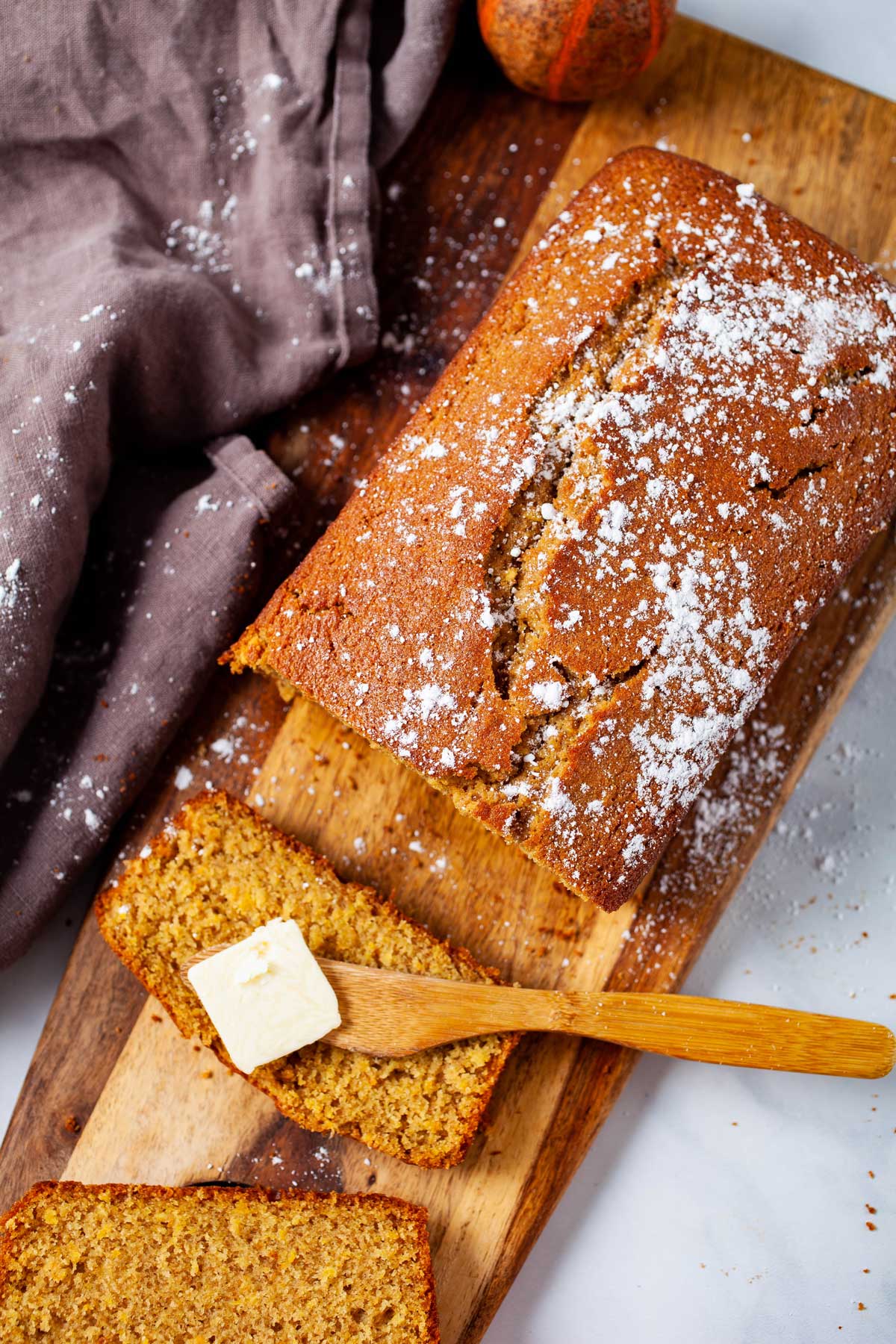
I usually make this moist cake for the Holidays, a special occasion, or get-togethers and serve it as an indulgent breakfast or with afternoon tea.
It's a delicious orange loaf cake that looks beautiful on any table and tastes amazing with a fresh orange flavor.
Don't forget also to check out my other breakfast cakes, like this Gluten-free Date Cake, a delicious Italian Dried Fig Cake, or this lovely Applesauce Cake.
Jump to:
Why You'll Love This Original Recipe
- It's incredibly easy to make.
- It has moist crumbs and a light texture and bakes nicely in a loaf tin or bundt pan.
- It has a delicious orange flavor.
- A tad of ground cloves adds warm, spiced undertones.
- A nutritious ancient grain such as spelt flour combined with real butter creates a very tender, light orange loaf cake that's irresistible.
- And with some wrapping and a little presentation, this orange-flavored cake can become the perfect gift.
Cake Ingredients
See the recipe card for full information on ingredients and quantities.
You only need a handful of ingredients to make this simple recipe.
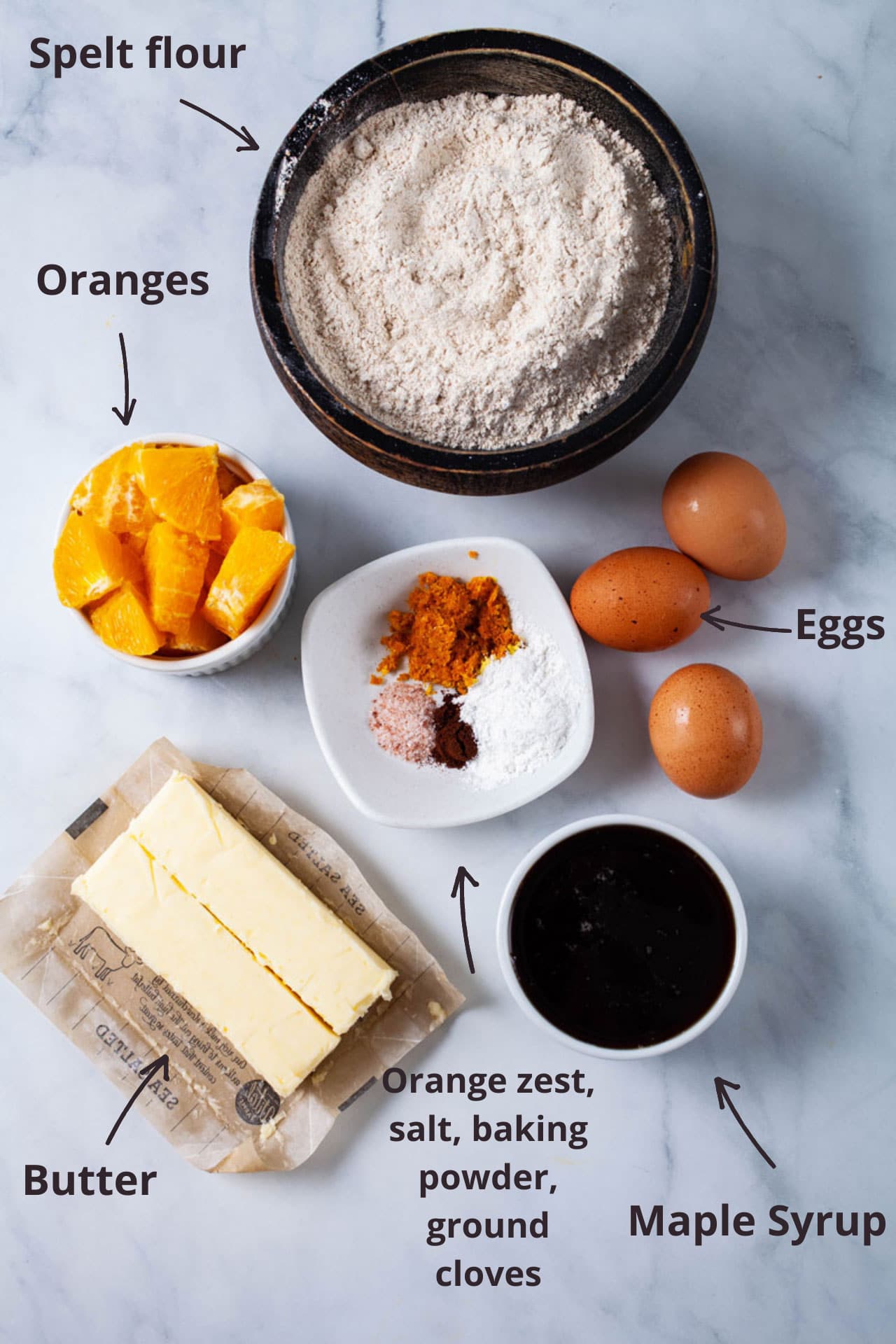
- Spelt flour: It's one of those ancient grains that are light and mildly sweet, with a lovely hint of earthiness, and adds a soft texture that aids in giving the cake batter its airiness. Because the gluten content of spelt flour tends to break down relatively quickly, it's excellent for quick bread recipes that don't require much mixing or kneading.
- Baking powder: Spelt flour is not self-rising, so the ingredients list also calls for some baking powder.
- Oranges: I use whole oranges, not just fresh orange juice. It intensifies the flavor.
- Orange zest: It'll enhance the citrusy taste and tanginess in the cake mix.
- Ground cloves: This spice adds warmth, and when paired with citrus fruit and a small amount of maple syrup, its warm aromas are enhanced.
- Large eggs: Use three beaten eggs.
- Unsalted butter: It adds wonderful flavor to this orange pound cake.
- Maple syrup: It adds natural sweetness together with the orange slices.
- Salt: For best results, add just ½ teaspoon.
How To Make It
See the recipe card for the full recipe with measurements.
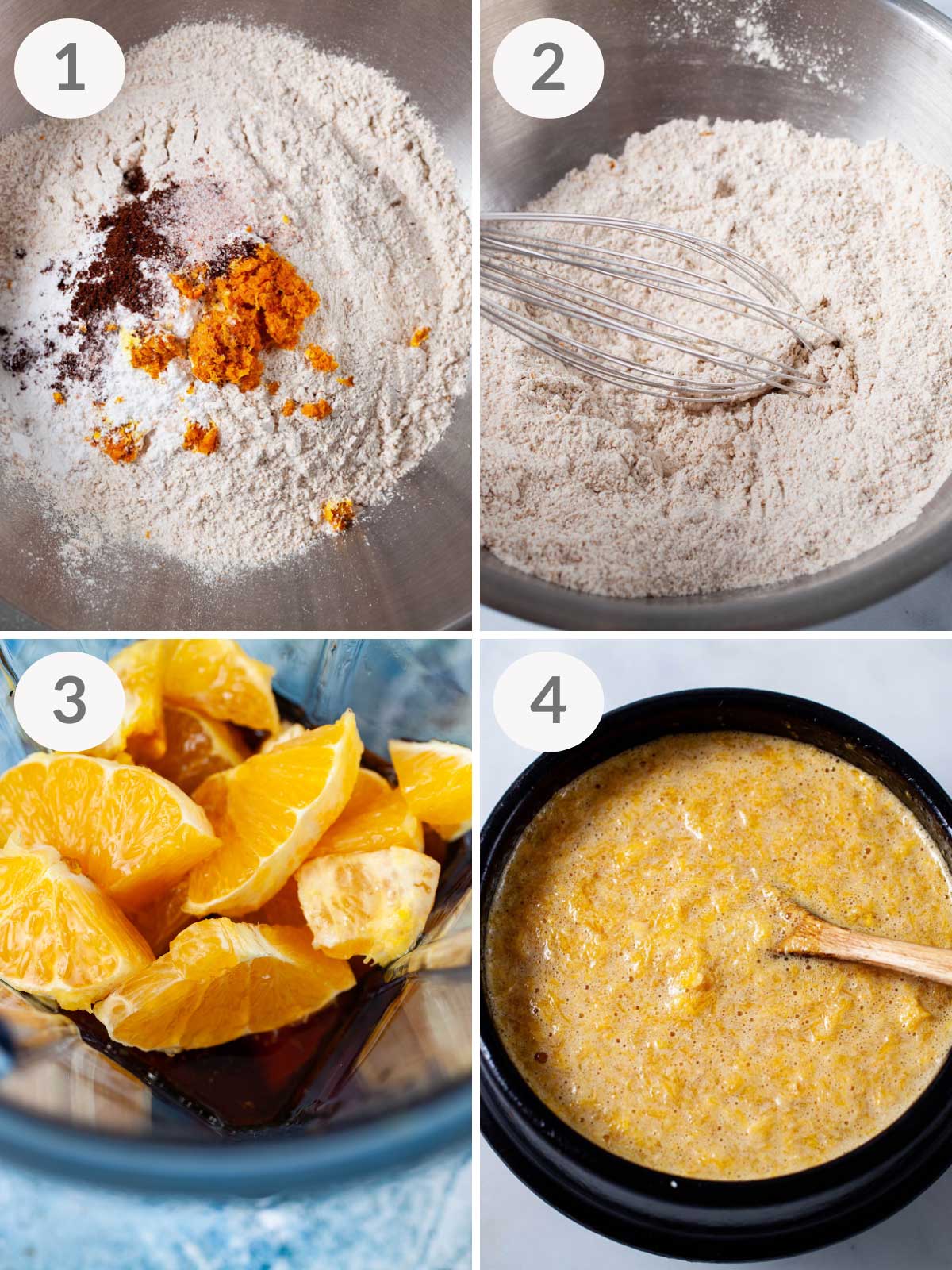
Step One (Picture 1 above) - In a large mixing bowl, add the dry ingredients like flour, baking powder, salt, and ground cloves, and add the orange zest.
Step Two (Picture 2 above) -Use a whisk to combine all the ingredients—set aside. Your flour mixture will smell deliciously orangy from the zest with a hint of cloves, but you won't see any zest or spices anymore.
Step Three (Picture 3 above) - In a high-speed blender, add the diced oranges and the maple syrup.
Step Four (Picture 4 above) - Blend into a fruity sweet puree—it's okay if you see a few strings from the oranges.
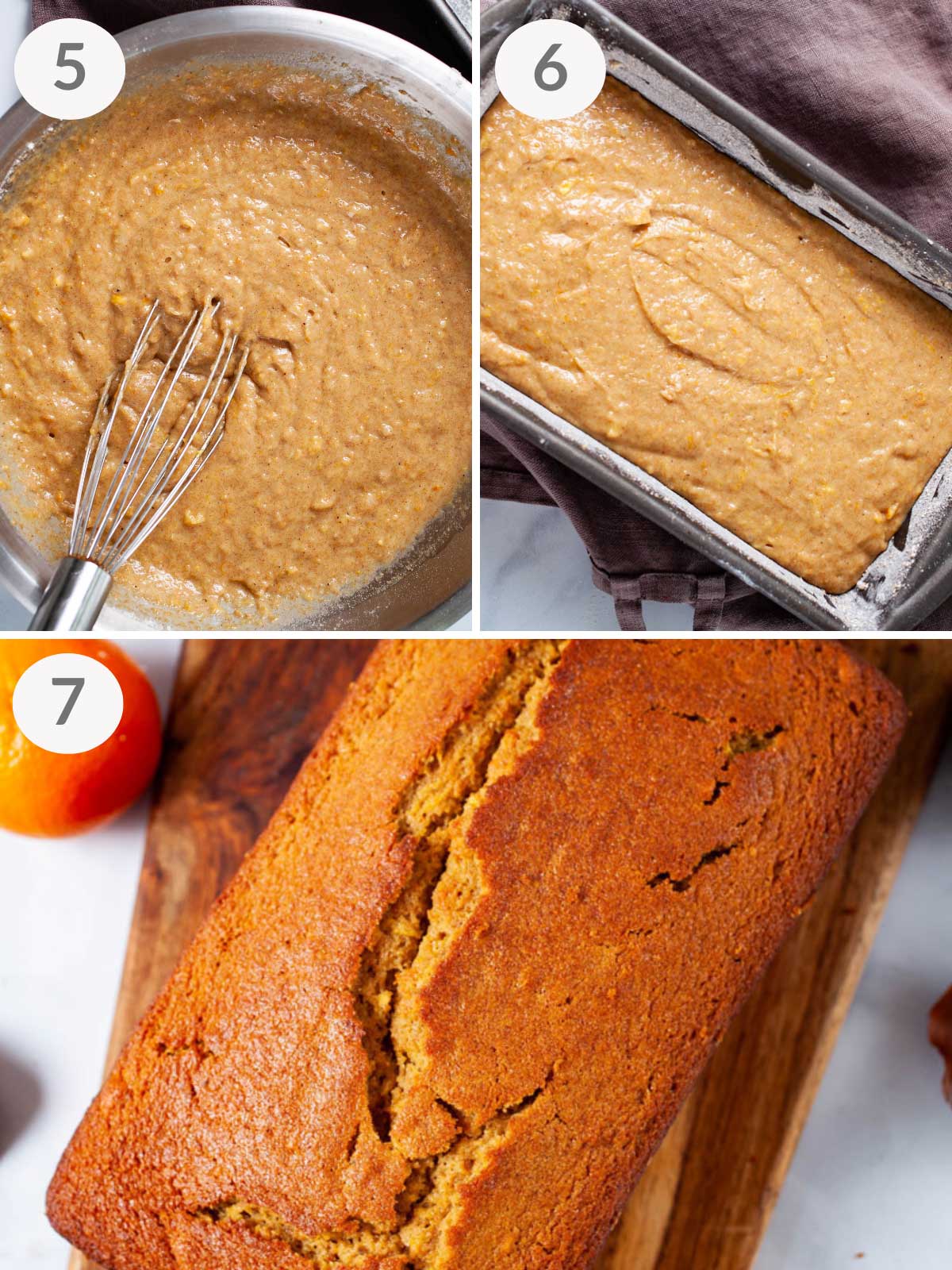
Step Five (Picture 5 above) - Add the sweet fruity blend and the rest of the wet ingredients (melted butter and beaten eggs) to the reserved dry mixture. The batter should look airy and orangy in color.
Step Six (Picture 6 above) - Pour batter into a prepared loaf pan.
Step Seven (Picture 7 above) - Bake in a preheated oven until a toothpick inserted in the center of the cake comes out clean.
Extra Baking Tips
- Always prep the loaf pan. Otherwise, getting the orange cake loaf out in one piece will be nearly impossible. You can use parchment paper or grease every inch of the loaf pan with butter, shake in a bit of flour (again coating all sides), and tap out the excess.
- How to best melt the butter: I quickly melt the butter on the stove in a small saucepan and over a low heat setting, stirring frequently. It doesn't take long, but I recommend staying with it until it's completely melted.
- Orange zest & grater: The best tool to zest an orange is a Microplane or citrus zester—most ideal—or in the absence, use the fine shred of your regular grater. Just make sure to get a fine zest with no white pith.
- Oranges: Go for juicy, sweet fruits like navel oranges. It gives this spelt cake that beautiful golden color and a wonderful orangy aroma. Even blood oranges can work here.
- If you can, use organic fruits: Because you are using the zest from the orange, I recommend choosing organic fruits for this recipe. Usually, one large orange gets me about one tablespoon of orange zest. But I suggest having extra oranges on the side if yours come in smaller sizes. You can always use any leftovers to make this amazing orange carrot soup.
- Cloves: This aromatic spice has an intense flavor, so I only use half a teaspoon here. However, if you love a more robust clove flavor, add about ¾ teaspoon of ground cloves.
- Use a whisk to combine the dry ingredients with the zest ingredients. A good old whisk will also aerate the flour mixture, making it more fluffy, resulting in a lighter cake texture.
- Baking time: My orange loaf cake always bakes for precisely 60 minutes. However, It's best to check and test for doneness at around 50 minutes into baking time. Depending on your oven type, you might need an extra 5 minutes or so.
- To check for doneness, I usually insert a toothpick in the center of the cake. If it comes out clean, the orange cake is ready.
- Cool the cake: Always cool the cake before removing it from the loaf pan. How long it takes to cool the Spelt cake will depend on the room temperature. I do not recommend placing it in the fridge to speed up the process—the cake might lose some of that lovely buttery and moist texture—it's worth the wait.

This orange spelt cake has almost all the pleasant smells of warm mulled wine!
How To Serve This Spelt Cake
A slice of this orange-clove butter loaf cake tastes excellent on its own, but feel free to dress it up with:
- Some butter and homemade spread—like this Simple Cranberry-Clementine Spread or rhubarb compote.
- A dollop of apple butter or creamy yogurt always works and is one of our favorite toppings;
- Or pair it with something heartier, like a slice of your favorite hard cheese.
Recipe FAQs
Wrap the loaf of quick bread in wax paper or unbleached parchment paper, and then place it in an airtight container once completely cooled—it will stay soft and fresh for up to 5 days.
Leave it stored at room temperature.
Use a sharp, thin-bladed knife and carefully run it around the cake's edges. Place a large enough plate over the cake and invert it while holding the plate firmly in place.
Tap and gently shake the pan so the cake can come out in one piece. Set the pan aside. The cake is now upside down. Gently turn the cake back around—and voila.
It's best to cut the cooled spelt cake with a bread knife into lovely bread-shaped slices, thick enough to smear on some butter or jam, or top it with light yogurt.
Want to gift the cake or make it extra festive? Dust powdered or confectioners' sugar on top of the cake for a beautiful snow-like effect, and use kraft paper bread bags for the wrapping.
You Might Also Like
Don't forget to subscribe to my Monthly Newsletter!
Your shares and ratings are valuable to me and so much appreciated. They'll help me create more content you and others can enjoy!
Here you have it, a beautiful cake that's buttery and made with whole-grain flour, unrefined sugars, and warm spices.
The aromas will fill the house when this delicious cake comes out of the oven, drawing everyone into the kitchen wanting a slice.
📖 Recipe

Moist Orange Loaf Cake With Spelt Flour
Mariska RamondinoEquipment
- 1 bowl and a whisk or use a bowl of a stand mixer with a whisk attachment.
- 1 Blender
Ingredients
- 2 ¼ cups spelt flour 280 grams, plus more to coat the pan
- 3 teaspoons baking powder
- ½ teaspoon salt
- ½ teaspoon ground cloves
- 1 tablespoon orange zest from one large orange
- 1 cup packed diced oranges about two small or one large orange—200 grams
- 1 cup maple syrup 280 ml
- 3 eggs beaten
- 1 cup butter melted (227 grams or two ¼ pound butter sticks), plus more to coat the pan
Instructions
- Preheat the oven to 350 degrees F/ 180 degrees C.
- In a large bowl, combine the flour, baking powder, salt, ground cloves, and orange zest. I use a whisk to mix these ingredients, break up any clumps and fluff up the flour—set aside.2 ¼ cups spelt flour, 3 teaspoons baking powder, ½ teaspoon salt, ½ teaspoon ground cloves, 1 tablespoon orange zest
- The flour will smell deliciously orangy from the zest with a hint of cloves aroma, but you won't see any zest or spices anymore.
- In a blender, add the diced oranges and maple syrup. Blend until pureed and well combined—it's okay if you see a few strings from the oranges.1 cup packed diced oranges, 1 cup maple syrup
- Transfer the pureed orange-maple syrup mixture into the reserved flour bowl. Stir to combine, and then add the beaten eggs and melted butter.3 eggs, 1 cup butter
- Stir everything using a whisk until well combined, and you get a beautiful light orangy batter. The batter will be wet but airy and fluffy.
- Coat the inside of the loaf pan with butter, then shake in a bit of flour (coating all sides), and tap out the excess.
- Pour the batter into the prepared pan. You can use a spatula to spread it out evenly.
- Bake in the center of the oven for 50 to 60 minutes, or until the top is golden brown, the loaf is springy to the touch, and a cake tester (or toothpick) inserted in the center comes out clean.
- Cool completely before removing from the pan.
Notes
Add your own private notes
Whenever you come back to this recipe, you’ll be able to see your notes.
Nutrition (% Daily value)
Disclaimer: This nutritional data is calculated using third party tools and is only intended as a reference.


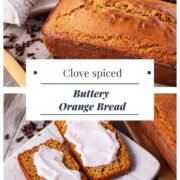

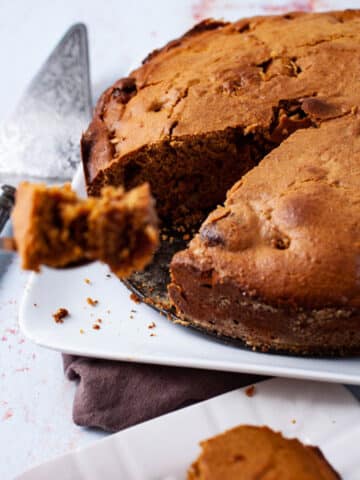
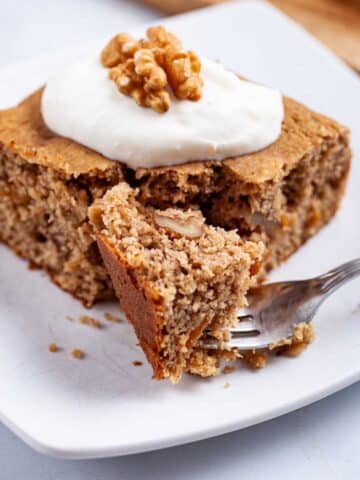
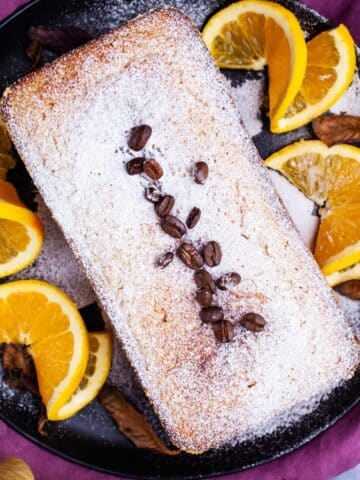
Leave a Reply